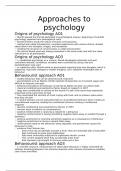Approaches to
psychology
Origins of psychology AO1
♡ Wundt opened the first lab dedicated to psychological enquiry, beginning of scientific
psychology separate from philosophical roots
♡ Wundt aimed to study the nature of human consciousness
♡ method was called introspection- recorded experiences with various stimuli, divided
observations into thoughts, images, and sensations
♡ isolating the structure of consciousness is called structuralism
♡ the stimuli Wundt used was always presented in the same order and with the same
instructions to all participants
Origins of psychology AO3
♡ s- established psychology as a science, Wundt developed systematic and well-
controlled methods, extraneous variables were controlled by using a lab and
standardisation was used
♡ w- subjective data, Wundt relied on participants reporting their own thoughts, which is
subjective, may have changed or hidden thoughts, can’t establish meaningful laws of
behaviour
Behaviourist approach AO1
♡ studies behaviour that can be observed and measured
♡ psychologists such as Watson (1913) rejected introspection as it involved vague and
difficult to measure concepts
♡ behaviourists believe all behaviour is learned as babies are born as a blank slate
♡ classical conditioning presented by Pavlov based on research in 1927
♡ dogs were conditioned to salivate at the sound of a bell if the sound was repeatedly
presented at the same time as food
♡ they associated the stimulus of a bell ringing with food, and so produce saliva when
they hear the bell
♡ a neutral stimulus can be associated with an unconditioned stimulus which creates an
unconditioned response, leading the conditioned stimulus creating a conditioned
response
♡ operant conditioning was presented by Skinner in 1953
♡ humans learn to behave via consequences
♡ positive reinforcement is receiving a reward for a behaviour
♡ negative reinforcement is having something negative taken away or avoided through a
behaviour
♡ positive punishment is receiving something negative as a consequence of behaviour
♡ negative punishment is having a reward taken away
♡ reinforcement leads to the behaviour being repeated, and punishment causes the
behaviour to stop
♡ evidence from Skinner box
- Every time rats accidentally activate a lever, they are rewarded with a food pellet
- Rats continued to press lever deliberately
- Rats were continually subjected to unpleasant electric current
- This current stopped when they accidentally press lever
- Rats learned to go straight to the lever when put in box
Behaviourist approach AO3
♡ s- scientific research, measurement of observable behaviour in highly controlled lab
settings, breaking behaviour into stimulus response units removes extraneous variables,
clear cause and effect
, ♡ s- applications, operant conditioning basis of token economy systems, classical
conditioning applied to treatment for phobias
♡ w- too environmentally deterministic, reducing behaviour to simple components
ignores influence of thought processes, ignores influence of any free will on behaviour
♡ w- flawed studies, rat box was unethical so cannot be repeated and checked for
reliability, cannot generalise learning process of rats to humans
Social learning theory AO1
♡ SLT says behaviour is learned through the observation and imitation of others
♡ vicarious reinforcement means imitation occurs if we observe behaviour being
rewarded rather than punished
♡ the learner observes the behaviour and the consequences
♡ mental factors mediate the learning process to determine whether a new response is
acquired- mediational processes
♡ attention- the extent to which we notice certain behaviours
♡ retention- how well we remember the behaviour
♡ motor reproduction- the ability of the learner to perform the behaviour
♡ motivation- the will to perform the behaviour, determined by whether it was rewarded
or punished
♡ identification means children are more likely to imitate people they identify with
♡ this person is their role model, and imitating them is modelling
♡ role models have similar characteristics as the observer, and has high status
♡ Bandura and Walters (1963) show 3 groups of children videos of adults behaving
aggressively towards a Bobo doll
- Group 1 sees the adults praised for this behaviour
- Group 2 sees the adult punished
- Group 3 sees no consequence
- When given their own Bobo doll, group 1 was most aggressive and group 2 least
Social learning theory AO3
♡ s- recognises cognitive factors, humans and animals store information about behaviour
of others to make judgements about appropriate actions, more comprehensive by
including mediational processes
♡ s- real world application, useful to explain how social and cultural norms are
transmitted, applied to gender roles
♡ w- contrived lab studies, main purpose of a Bobo doll is to strike it, children did so as it
was expected of them
♡ w- mirror neurons in the brain allow us to empathise with and imitate other people,
biological influences were under-emphasised in SLT
Cognitive approach AO1
♡ says internal mental processes should be studies scientifically
♡ studies processes such as memory and thinking which are private (cannot be directly
observed) by making inferences from behaviour
♡ schemas- packages of ideas and information based on experience
♡ they act as a mental framework for the interpretation of incoming information
♡ babies are born with simple motor schemas for innate behaviours
♡ as we get older schemas become more detailed and complex, allowing us to process
lots of information quickly
♡ schemas may distort our interpretations of sensory information, leading to perceptual
errors
♡ cognitive psychologists use theoretical and computer models to understand internal
mental processes
♡ the information processing approach suggests information flows through the cognitive
system in a sequence of stages
♡ cognitive neuroscience is the study of how brain structures influence mental processes
♡ with the development of new brain scanning techniques, scientists can systematically
observe the neurological basis of mental processes
♡ this has led to developing mind mapping techniques such as brain fingerprinting




